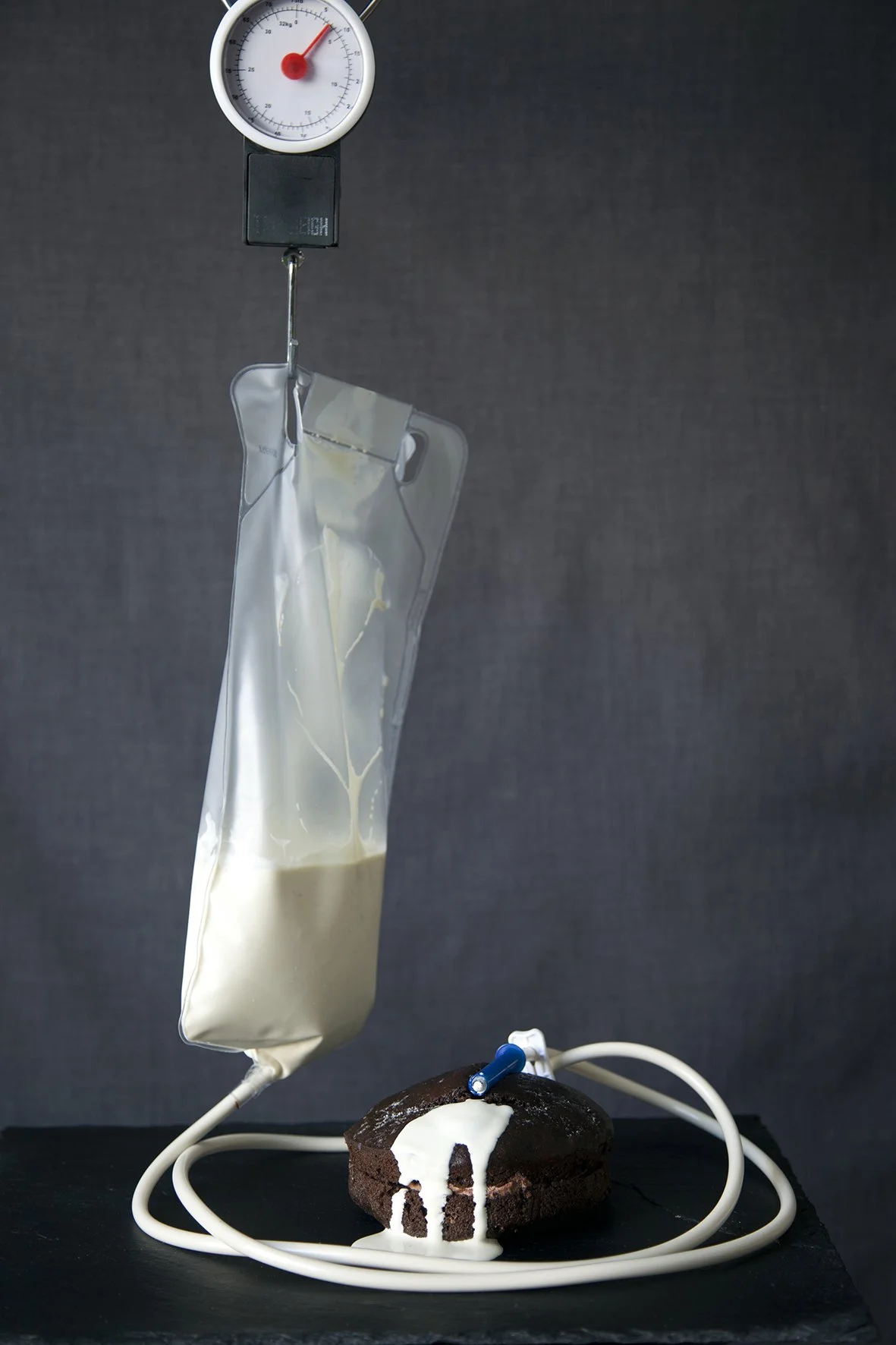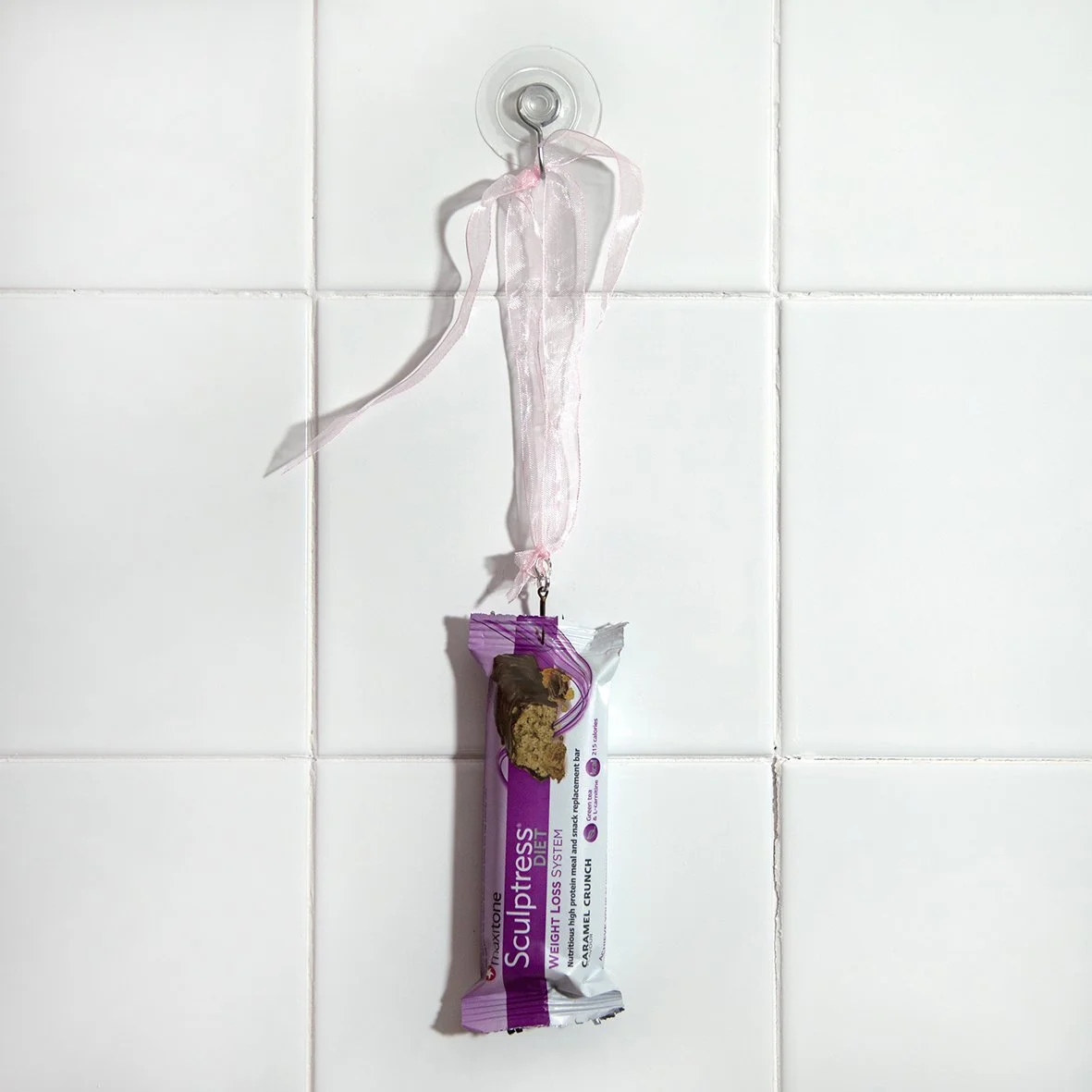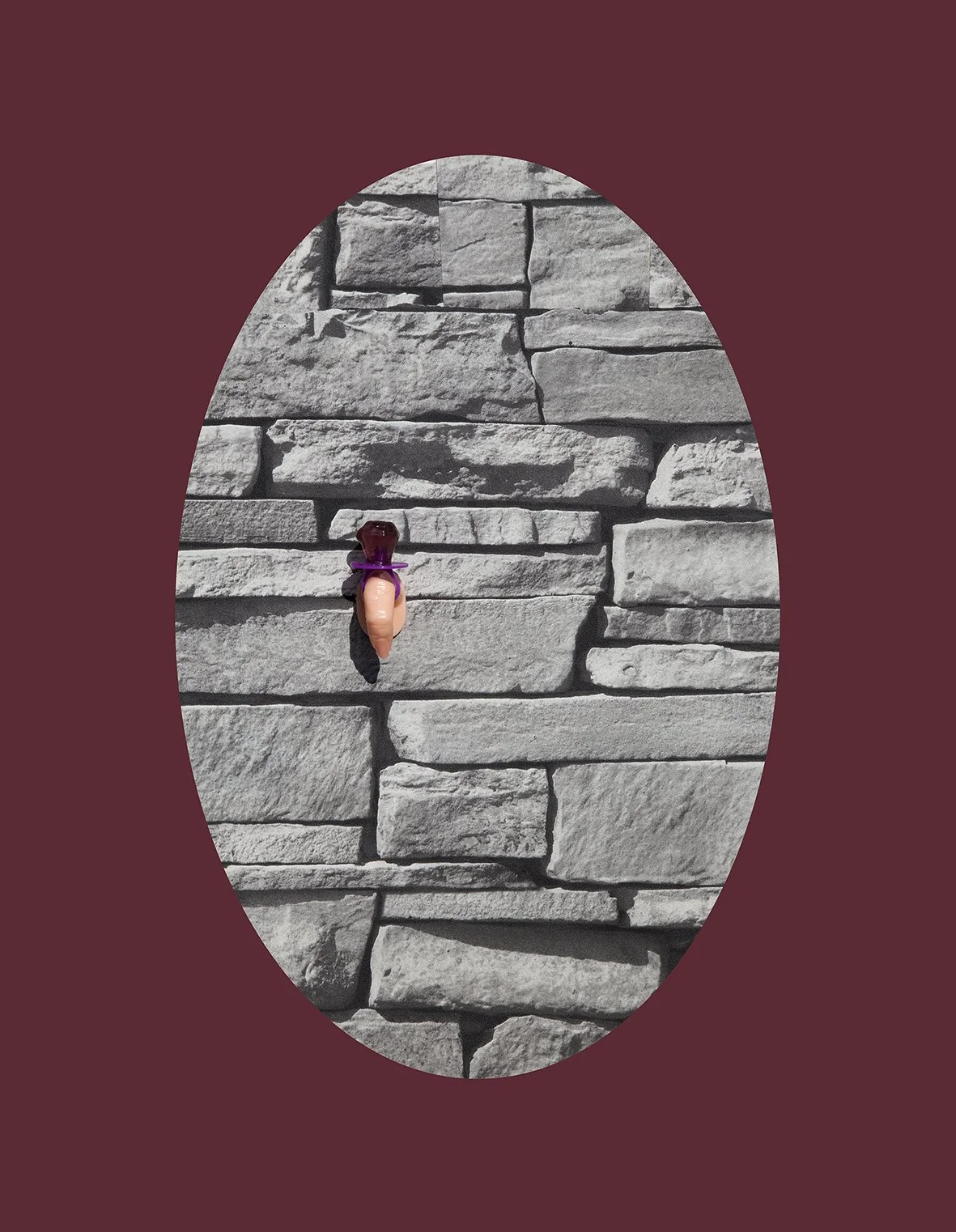As this issue on consumption, we thought we would add an extra special feater on an artist whose work revolves around this subject. As well as this Q&A, Dawn, explains a bit more about her practice and how it has evolved, and specific pieces of work.
Dawn’s work is a feminist critique of consumer culture, During her teens. Her work blurs the boundary between self-portraiture and still life, producing inanimate bodies and seemingly animate objects.
1 - Could you explain your creative practice? How did writing become a part of your art practice?
I have always been a researcher, so I have always written about the subjects that my artwork centres on, however, a few years ago I did a Ph.D. by the project which formalised that practice. My Ph.D. research examined contemporary consumer culture and its impact on the relationship between consumers and their bodies. I created still-life photographs to explore and express this topic. Despite my focus on still life I ended up writing about social media and selfie practices and this became the subject of the book titled Consuming the Body: Capitalism, Social Media and Commodification which is due to be published by Bloomsbury in October. It is an academic book that stills alongside my exhibition and catalogue Consumed: Stilled Lives.
In terms of creative writing, I wrote a script for a sound-piece called Sirens, which uses hashtags to embody the voices of commodities. Many of the hashtags derive from commodity branding but some were made up in order to express and unpack the ideological values of the commodities. The hashtag poems first appeared in an Instagram site-specific artwork called #WishBook. More recently I wrote a creative piece about my performance practice called ‘Practicing In Between’ for a Field Notes publication by Two Destination Language.
2 - Is having a creative practice in art or writing relevant today? Do you think it is encouraged enough in schools? Please let us know your opinion on this.
Art and creative writing offer tools for describing our experiences of the world and expressing the changes that are needed. As a feminist and anti-capitalist, I produce art that calls attention to gender and social inequalities. Creative forms can express complex ideas in ways that can be understood by a wide audience, making it an important tool for activism. If it is difficult for people to study and practice art they are also obstructed from undertaking one form of protest and voicing dissent so it is really important that we continue to fight for art subjects to be taught in all levels of education.
Sadly, creative practices have been devalued in school for many years, in contrast to business and tech subjects that are deemed to be good career choices. This is nonsensical because the creative and critical thinking skills that are developed in arts programs are transferable skills that are highly rated by employers. The creative industries also contribute a huge amount to the UK economy so the idea that studying art is a bad career choice is also quite simply untrue. Creative courses in universities are also suffering due to funding cuts because they are not valued by the government. These attacks on creative subjects in schools and universities is deeply worrying because they reduce access to creative subjects for working class and marginalised people, meaning that art is only produced by and for wealthy, privileged people who can afford to fund their own studies.
3 – We are always asked what other artists influence us, we want to know what artists and writers we don’t like, and which influence your’ practice?
Ha! Where to begin! I have a particular dislike for the male abstract expressionist painters, in part because the art history lecturers at Manchester Metropolitan University, where I did my undergraduate degree many years ago, really loved them and so there was a lot of focus on them. The way the artists wrote about themselves and the way that critics wrote about them really put me off – their words sound like patriarchal machismo – so from a feminist perspective I really don’t like them and do not find them interesting. That is also my reason for disliking Jeff Koons and Allen Jones – they fetishise women’s bodies in a highly reductive manner – and the work seems superficial like there is nothing beneath the slick surfaces.
I am positively influenced by a wide range of artists, from Claude Cahun’s gender-fluid self-portraits that were decades before their time, to Peter Kennard and KennardPhillips, anti-war and anti-capitalist collages and installations. I am also currently collaborating on a number of projects with artists that influence my ideas and work. Davin Watne (based in Kansas City) and I have been collaborating for the last 5 years, producing performances and installations that examine contemporary socio-political situations in the US and UK. For the last few years, Zara Worth (Leeds / Durham) and I have been writing, making artwork, and curating exhibitions that examine our shared interest in social media cultures. Both Davin and Zara use different media and have very different working practices to mine so I always find it inspiring and educational to work with them.
4- If you could go back to high school what would you tell your younger self?
Just to be me – if I even knew what that was back then (I’m not sure that I know it now)!
5 – If you could go forward 20 years what do you hope to have done or not done?
I hope that I have continued to focus on art practice and maybe written another book or two. Mostly, I hope to have devoted a good proportion of my time to traveling and doing the things that I enjoy. I have been very focused on work since my teens so I hope I’m able to slow down and enjoy life more as I get older.
Dawn can be contacted and see more of her work and recent exhibitions here…
Statment -
My artistic practice encompasses performance, photography, video, and installation. I examine contemporary consumer culture and the process of constructing ideal gendered bodies through commodification. I am particularly interested in new mechanisms of interaction afforded by new technologies such as smartphones and social media. It is a feminist critique: I examine representations of gender in adverts, magazines, tv programs, and social media in order to appropriate their visual language and expose the stereotypes they reproduce.
My work blurs the boundary between self-portraiture and still-life, producing inanimate bodies and seemingly animate objects. Ideas of embodied presence and liveness are played with and called into question in my work. I view my work as self-portraiture, but not in the traditional sense. In some of the work, such as The Substitute series, I create photographic substitutes of myself in order to examine the act of looking and being looked at. I use my own experience of being an object of sight to draw attention to the power relations of exhibitionism and voyeurism. My still-life images are also portraits that describe different types of consumers who possess and consume the objects on display. The variety of materials I use includes porcelain, rubbish, blancmange, and rotting meat.
I also create public domain interventions in physical commercial advertising spaces in cities and in virtual ones on online social networking sites. I hope to challenge advertising cultures in the commercial advertising spaces that my work critiques. The poster campaigns have been supported by the Arts Council of Wales (Cardiff, 2014-5), City Centre Posters (London, 2016), and the Lipman-Milliband Trust (Cardiff, 2015 and Leeds, 2018), and Leeds Arts University (2019 and 2021).
Celebrate (2012-9)
The objects in Celebrate suggest contradictory and troubling relationships to consumerism. I used different sculpture techniques including slip casting porcelain, moulding white chocolate and blancmange, and boiling sausage meat in surgical gloves. I used familiar materials to make objects that are unsettling because they are both desirable and threatening, enticing and repulsive.
In a traditional vanitas paintings, a bowl of fruit beginning to rot connotes that life is short and pleasure has consequences. In Vanitas (2012) the fruit is plastic and will not decay, suggesting a contemporary consequence of consumption.
The Blancmange Dentata diptych (2012) were made in response to written entries on ‘thinspiration’ and ‘pro-anorexia’ websites, in which anorexics describe the temptation of food and their attempts to suppress the desire to eat. The photographs suggest consumption is both threatening and appealing. The Tea Party photographs (2013-19) refer to the research into the visualisation of food in eating disorders: food is drained of colour and aroma to help suppress desire. In the photographs the food is inedible, eradicating its value as food. In the white photograph the food is made of the same porcelain as the containers, raising the food to the status of a crafted and delicate object. In the grey photograph the object is made of concrete, a common, inexpensive material. The black banquet is made from plastic, material that will not break-down and is indigestible. The different materials evoke the shifting status of food in the lives of eating disorder sufferers, in turn object of disgust and obsession. Food to be consumed is turned into petrified matter.
Each year during the Christmas and New Year holidays I am infuriated by adverts telling me to treat myself, over-indulge and let myself go, only to berate me for doing so as soon as the clock strikes midnight on the first of January. I began the Scales series for some advertising posters that were displayed in Cardiff in January 2015. The series of six photographs consider the social stigma attached to fat and the medicalisation of the overweight body.
Lure (2014)
Robert Crawford, a political economist, says that capitalism has two contradictory demands:
On one hand we must repress desires for immediate gratification and cultivate a work ethic, on the other, as consumers we must display a boundless capacity to capitulate to desire and indulge in impulse; we must hunger for constant and immediate satisfaction. The regulation of desire thus becomes an ongoing problem, constantly besieged by temptation, while socially condemned for over indulgence.[1]
In contemporary consumer culture I am required to delay gratification and demonstrate a strong work ethic in order to fulfill the need for production and achieve a slender body ideal. I am simultaneously impelled to consume to excess under the hedonist incitement to ‘treat myself’ in order to fulfill the need for consumption and capitalist growth. Lure focuses on this contradiction in advanced capitalist society. Diet foods are commodities par excellence; they conform to the dictum of self-denial without contradicting the imperative to consume. They simultaneously restrained and indulgent.
The objects in Lure, made from cakes, sweets, diet product packaging, fishing hooks, and lures, resemble fetishes or talisman, votive objects worn on the body to protect from illness or bad luck. They seem to offer protection against the effect of eating sugary treats, but the fishing equipment also suggest a trap and equivalence between duped prey and the consumer. Each image is composed and lit in the same way, because I wanted to create an art production line that mimics capitalist production processes and is designed to impel the consumer to collect the complete series.
Life Cycle (Pacifier / Memorials / Nature Morte) (2014-6)
Through a series of linked artworks I present the lifecycle of the female consumer, from the idealized teenager caught up in the commodified pursuit of perfection to the ageing, becoming obsolete, body sinking from view.
Pacifier (2014) considers consumption – particularly the body-labour required to achieve an ideal body – as a form of distraction. Sexualisation and infantilisation are implied by the sweets, sex toys and nail art practice dummies representing pacified consumers. These commodities transform the consumer into an erotic spectacle – a surface appeal without substance.[2] Decorative and sexual characteristics overpower the other aspects of the body. Each work contains multiple surfaces vying for attention, the textures of the faux surfaces in the ellipse directly compete with the objects they support and the coloured expanses surrounding them. The vignettes may be viewed as portraits or the beheaded trophies of a hunter.
Sirens (2016-7)
One of the most invasive developments of online advertising is autoplay videos. As I browse a page the soundtrack of an advertisement plays in the background and I am forced to look for the ad in order to stop it. I can choose not to look but it is difficult not to hear. I wanted the commodities from Hysterical Selfies to share this aggressive insistence, so I created Sirens. In Sirens the commodity speaks with an almost human voice, softly whispering its ideological messages. Allowing the commodities to speak brings attention to the absurdity of the messages.
Wishbook (2015-9)
The title Wishbook derives from nineteenth century commodity catalogues such as The Great Wish Book and American Dream Book, that sold the American way of life, homogenizing other cultures to the American ideal. The title also alludes to Benjamin’s idea that consumers can appropriate commodities as emancipatory wish images. To intervene in a commercial space in which advertising tactics are far more insidious than in traditional advertising media, I disseminated this work on Instagram using hashtags that reveal the commodities signifying message. The images look like poor quality adverts or the content of a bin and the hashtags read like bad poetry. They appear among adverts on social networking sites and behave abnormally.
https://www.instagram.com/dawncwoolley/
Relics 2017
The Relics series was made as the foreboding counterpoint to the bright glossy appeal of Lure.
For my still life photographs I collect packaging of commodities with names and branding that reinforce dominant gender stereotypes. Ironically, I find it difficult to dispose of the element of the commodity that is made to be thrown away. With a glue-gun, candle wax and a series of sketches produced in the anthropology museum in Cambridge, I made relics of advanced capitalism: our legacy for future generations.
Reminiscent of devotional artefacts and ceremonial figures such as totems, votive candles, and janus figures, these relics infer an overvaluation of commodities and packaging. They seem powerful. Made from different types of packing material, and beginning to show signs of age, these Relics are not sacred objects that are preserved for centuries because they are culturally significant. They are waste that cannot be destroyed. Like janus figures they reveal both sides of their nature: commodities to be worshipped and rubbish to be discarded, the sacred and the profane.
[1] ibid., p. 99.
[2] Dawn Woolley, Consuming the Body: Capitalism, Social Media and Commodification, London: I B Tauris, 2019.











